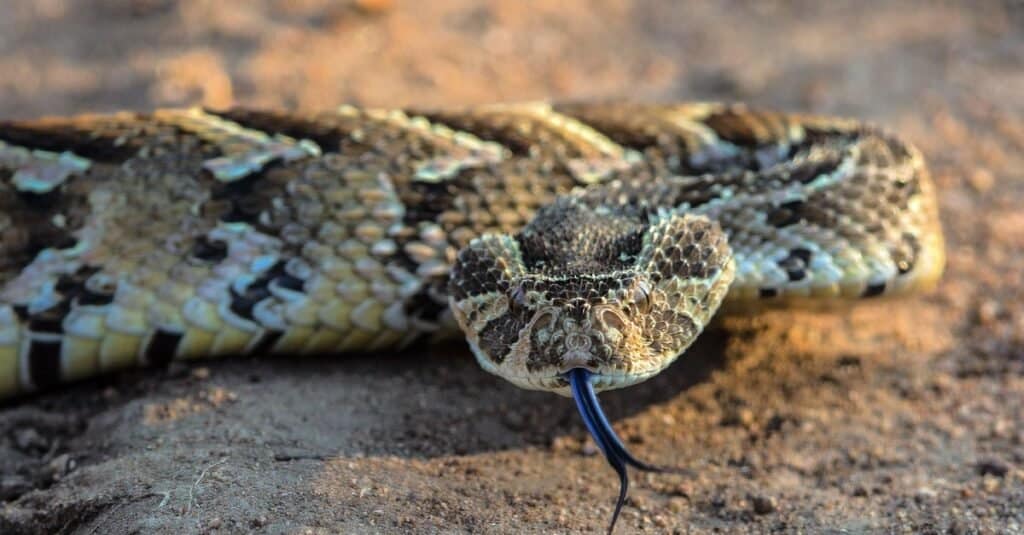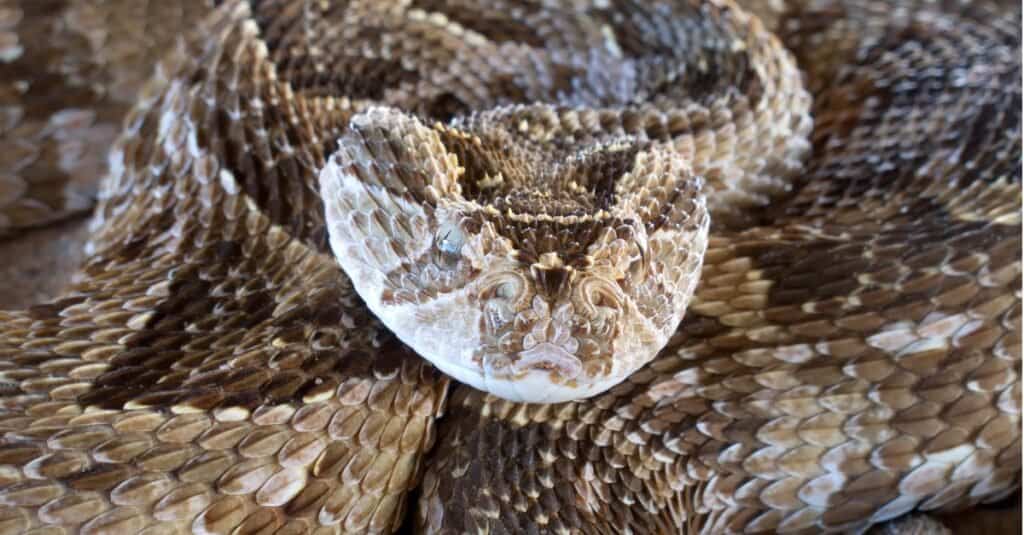Puff Adder
.jumbotron {
background-image: url(“https://a-z-animals.com/media/2022/01/puff-adder-400×300.jpg”);
}
}
@media only screen and (min-width: 641px) and (max-width: 920px) {
.jumbotron {
background-image: url(“https://a-z-animals.com/media/2022/01/puff-adder-470×370.jpg”);
}
}
@media only screen and (min-width: 921px) {
.jumbotron {
background-image: url(“https://a-z-animals.com/media/2022/01/puff-adder.jpg”);
}
}
Puff Adder
Bitis arietans
This large snake is so-named because it will puff up its body to appear bigger than it is when directly threatened by a predator or person.
Puff Adder Scientific Classification
- Kingdom
- Animalia
- Phylum
- Chordata
- Class
- Reptilia
- Order
- Squamata
- Family
- Viperidae
- Genus
- Bitis
- Scientific Name
- Bitis arietans
Read our Complete Guide to Classification of Animals.
Puff Adder Conservation Status
Puff Adder Facts
- Prey
- Rodents, frogs, birds, insects, and other reptiles
- Group Behavior
-
- Solitary
- Fun Fact
- This large snake is so-named because it will puff up its body to appear bigger than it is when directly threatened by a predator or person.
- Other Name(s)
- African puff adder, common puff adder
This post may contain affiliate links to our partners like Chewy, Amazon, and others. Purchasing through these helps us further the A-Z Animals mission to educate about the world’s species..

Discover alligator-eating snakes, spiders larger than your phone, and 1000 more incredible animals in our daily FREE email.
.photo-gallery {
–margin: 0px auto 0px;
–padding: 0px 0px 0px 0px;
}
.gallery-link {
background-image: url(“https://a-z-animals.com/media/2022/01/puff-adder-1024×535.jpg”);
background-repeat: no-repeat;
background-size: cover;
background-position: center;
height: 500px;
justify-content: center;
text-align: center;
align-items: center;
display: flex;
border: 2px solid #000;
}
.gallery-link img {
height: 50%;
}
@media only screen and (max-width: 768px) {
.gallery-link {
height: 300px !important;
}
}
View all of the Puff Adder images!
“The puff adder is thought to be responsible for more snake bites and fatalities than any other species in Africa.”
This large snake is so-named because it will puff up its body to appear bigger than it is when directly threatened by a predator or person. As a highly aggressive and venomous species, contact with them should be avoided at all costs. This article will cover some interesting facts about the identification, size, location, venom, and diet of the puff adder.
5 Incredible Puff Adder Facts!
- The puff adder’s mating season takes place every year between October and December, when females will release a strong pheromone to attract a mate. After a lengthy courtship ritual and so-called combat dance, in which the snakes appear to writhe around and wrestle, the female will either choose to accept or reject him. Both sexes will have multiple mates per season.
- Once impregnated, the female will lay 20 to 50 live young (not eggs) in April. The offspring will reach sexual maturity at four years old and have a typical lifespan of 13 to 16 years in captivity. Lifespan in the wild, so often cut short by predators, is difficult to estimate.
- Like most snakes, puff adders can sense vibrations through the ground.
- In the wild, puff adders have several potential predators, including eagles, hornbills, warthogs, honey badgers, and cobras. Their dull colors enable them to blend in with the surrounding environment and avoid detection. They also have the ability to mask their scent.
- Puff adders can be active day or night, but they tend to be nocturnal predators, meaning they come out at night to hunt for prey.
Where to Find Puff Adders
The puff adder can be found in various semi-arid locations, including savannas, open forests, and grasslands, throughout most of sub-Saharan Africa, parts of Arabia, and Morocco. These snakes do need a source of water nearby and an adequate amount of coverage. However, they are not generally found in the rainforest habitats of central Africa.
button.pulse {
transform: scale(1); animation: pulse 2s infinite;
box-shadow: 0 0 0 0 rgba(11, 247, 25, 1);
}
@keyframes pulse {
0% { transform: scale(0.90); box-shadow: 0 0 0 0 rgba(11, 247, 25, 0.5); }
60% { transform: scale(1); box-shadow: 0 0 0 15px rgba(11, 247, 25, 0); }
100% { transform: scale(0.90); box-shadow: 0 0 0 0 rgba(11, 247, 25, 0); }
}
Scientific Name
The scientific name of the puff adder is Bitis arietans. This name is derived from the Latin word arieto, meaning to strike violently. Puff adders are closely related to the horned adder, red adder, and other species within the genus Bitis. Because of its wide geographical distribution, there are two recognized subspecies: the African puff adder and the Somali puff adder.
Puff adders go by a few names which include common puff adder and African puff adder.
Population and Conservation Status
According to the IUCN Red List, the puff adder is considered to be a species of least concern. We do not have enough facts about their population numbers to make a good estimate, but they appear to be very common and widespread across most of their natural range.
Appearance and Description
The puff adder is a very thick, medium-sized snake, measuring an average of about three feet long. It is characterized by tan, brown, gold, and even gray skin colors with irregular wavy patterns, alternating between dark and light, along the side of the body. The subdued colors help them blend in with their natural habitats. Although the sexes are otherwise similar to each other in appearance, females can be distinguished from males by the slightly shorter tail. The size difference should help quite a bit in the identification of the sexes.
How to identify the puff adder:
- Big, thick body that reaches up to five feet long
- Triangle-shaped head
- Long sharp fangs that inject venom
- Alternating dark and light wavy or chevron patterns
Pictures

iStock.com/S_Lew

iStock.com/EcoPic

iStock.com/EcoPic
Venom: How Dangerous Are They?
The puff adder produces a powerful toxin that directly attacks and destroys tissue. Some of the effects of its toxin include bleeding, swelling, pain, nausea, local muscle weakness, and tenderness. The venom is intended to completely immobilize smaller prey so they cannot escape from or injure the snake in any way. Although the venom is highly dangerous, the prognosis is generally quite good for people who receive the antivenom treatment in time. Without the antivenom, however, the fatality rate can easily exceed 15% (depending on the severity of the bite).
Behavior and Humans
There are several factors that make these snakes incredibly dangerous to people, including their large size, their wide geographical range, their tendency to bask on footpaths, and their long fangs and very toxic venom. Because they like to wait quietly for prey while camouflaged against the ground, people will often stumble upon them without even noticing they are there. When directly threatened or disturbed, they would rather stand their ground than flee. They will puff up their bodies and give a warning hiss before striking.
View all 117 animals that start with P
Puff Adder FAQs (Frequently Asked Questions)
Are puff adders venomous?
Yes, puff adders are among the most venomous snakes in Africa.
How do puff adders hunt?
Puff adders are ambush predators. They will remain hidden and unmoving along the ground, sometimes for several weeks, while relying on chemical and heat signals to sense prey. After the prey wanders by, they strike out and bite it with their long fangs. The prey is usually swallowed whole.
Are puff adders aggressive?
Yes, puff adders are considered to be highly aggressive. They strike quickly and do not tend to run away and hide from threats.
Where do puff adders live?
Puff adders live in various semi-arid locations around sub-Saharan Africa and parts of Arabia, as well as one small section of western Morocco.
What do puff adders eat?
The diet of the puff adder consists of rodents, birds, frogs, other reptiles, and even small deer. Juveniles consume smaller animals and insects as well. Surprisingly, they do provide some benefits to humans. By controlling vermin populations, they prevent pests from consuming crops and spreading diseases (although this is often outweighed by the number of people they kill every year).
What is a puff adder?
A puff adder is a big venomous snake endemic to many habitats throughout Africa. As a member of the viper family, they are defined by long hinged fangs that penetrate deep into the skin and inject venom. Featuring a dark to light chevron-like skin pattern, the body is generally quite heavy and thick, although perhaps not quite as long you would expect. Identification isn’t too difficult to make, but it can be accidentally mistaken for a few other types of adders as well.
Can a puff adder kill you?
Yes, the puff adder appears to be responsible for a large proportion of the 32,000 snake bite deaths in Africa annually.
How poisonous is the puff adder?
The puff adder is among the most venomous reptiles on the continent. It can deliver a very high amount of toxins that can kill people with a single bite.
What happens if a puff adder bites you?
The venom prevents the blood from properly forming clots. It can also directly lead to tissue death. In extreme cases, it can cause significant skin damage that spreads outward from the bite site. Permanent scarring is possible.
If a puff adder bites, how long will you live?
The answer to that question depends on many factors, including age, health, and severity of the bite. The majority of people will end up living, even without the antivenom treatment, albeit with significant suffering. Because the effects work slowly, death usually takes two to four days without treatment. Fortunately, the antivenom should almost eliminate the risk of death.
How did a puff adder get its name?
The meaning of the name comes from the ability to puff up its body to appear larger than it really is. This is designed to frighten dangerous predators that may try to attack it.
What’s the difference between a rattlesnake and a puff adder?
The key differences between Rattlesnakes and Puff Adders are in terms of classification, size, range, and habitat.
Let’s explore these differences here.
Sources
- Animal Diversity Web, Available here: https://animaldiversity.org/accounts/Bitis_arietans/
- African Snakebite Institute, Available here: https://www.africansnakebiteinstitute.com/snake/puff-adder/
















